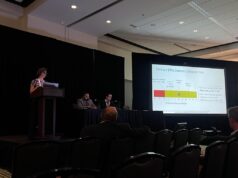
In a subgroup analysis of the STRIKE-PE study regarding patients treated with the latest iteration of Penumbra’s 16Fr Lighting Flash computer-assisted vacuum thrombectomy (CAVT) device, Brian J Schiro (Miami Cardiac & Vascular Institute, Miami, USA) reported improved haemodynamic markers, right/left ventricle (RV/LV) ratio, dyspnoea, and overall, a “highly” improved device use time of 25.5 minutes.
In the outset of Schiro’s presentation at the Society of Interventional Radiology (SIR) annual scientific meeting (29 March–2 April, Nashville, USA), he described that the goals of pulmonary embolism (PE) treatment are haemodynamic stability, perfusion restoration and right heart strain relief, among others. “Functional analysis is also important,” Schiro noted, stating that the consideration of long-term issues in these patients is as important as immediate improvement in symptoms.
Initially, he described the evolution of endovascular treatment of PE, outlining the progression from thrombolytics, to continuous aspiration, and now, CAVT, the “next-generation” treatment modality.
The present analysis of the STRIKE-PE study evaluated periprocedural and functional results of the first 164 acute PE patients enrolled and treated with CAVT using the 16Fr Lightning Flash system. The device comprises an aspiration catheter and a microprocessor programmed to optimise regulation of aspiration by using pressure differential and flow-based algorithms to rapidly detect thrombus from blood flow.
Among their 164 acute PE enrollees, the average patient age was 61.6 years, and 53.7% were male. PE risk stratification was high in 4.9% of patients, intermediate-high in 86.6% and intermediate-low in 8.5%. The median thrombectomy time was 25.5 minutes and median procedure time was 59 minutes. Schiro reported that mean on-table pulmonary artery pressures (PAPs) “significantly decreased”—systolic PAP from 50.8mmHg to 38.8mmHg (23.4%, p<0.001), and mean PAP from 31.2mmHg to 23.5mmHg (24.5%, p<0.001)—demonstrating the device’s effect, providing “quick haemodynamic improvement and stability”.
Mean RV/LV ratio decreased from 1.34 at baseline to 0.94 at 48 hours (27.8%, p<0.001). The speaker noted that one composite major adverse event (0.6%) occurred within 48 hours; however, no device-related serious adverse events were reported. Six patients required pre-discharge transfusion. “Most of these were related to the patient’s underlying conditions”, Schiro stated; however, no major bleeding required transfusion and there were no device-related transfusions. Additionally, median Borg dyspnoea score at rest decreased from 5 (severe [heavy]) at baseline to 0.5 (very, very slight [just noticeable]) at discharge.
“What we really want to highlight here is the procedure time and the time of thrombectomy,” Schiro told SIR delegates. He compared the 16Fr Lightning Flash to devices used in the APEX-AV, FLASH and PEERLESS trials, which had procedure times of 37.2, 43, and 47.5 minutes, respectively.
“The most impressive figure really is that short device time. We achieved exceedingly short procedures compared with some of the other trials that have been reported,” Schiro said. “With the [16Fr Lightning Flash] device, we continue to see significant improvements in the patient’s status, including RV/LV ratio, functional status and an excellent safety profile,” he stated.













